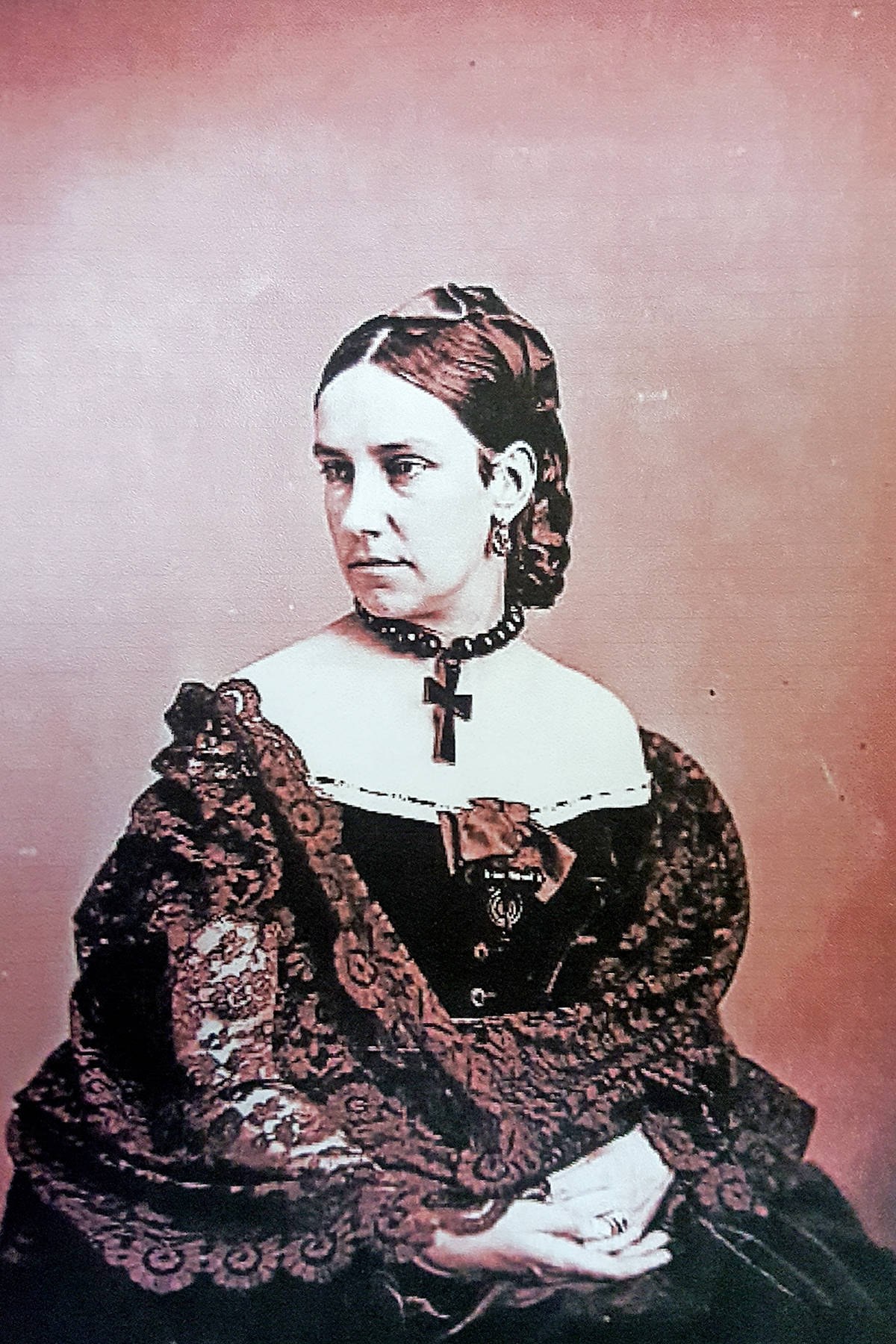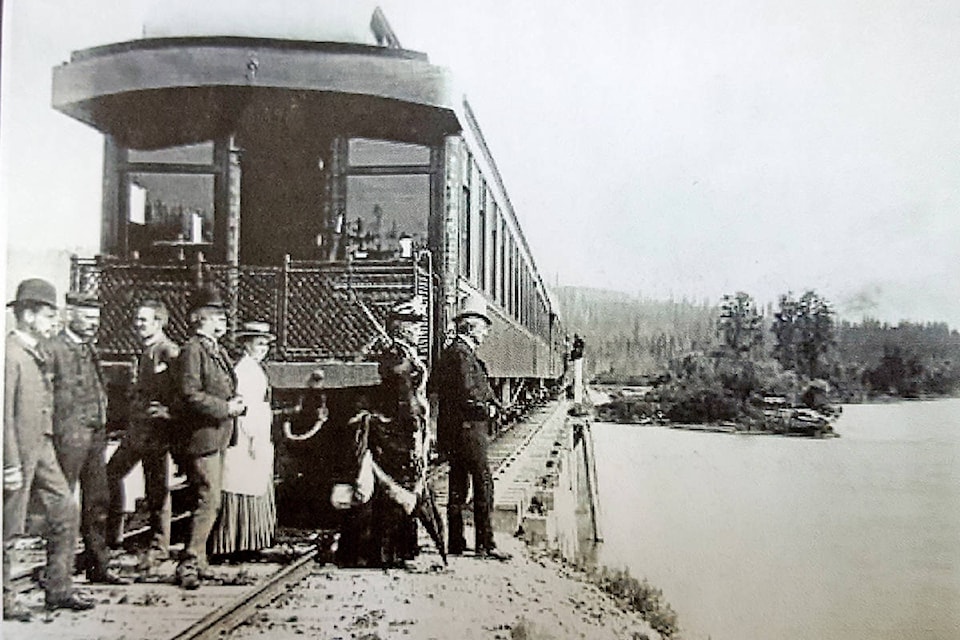This article has nothing to do with the gold rush, or with Williams Lake, but it is an unusual piece of Canadian history which deserves to be retold.
In 1885, the last spike was hammered into the Canadian Pacific Railway at Craigellachie, and for the first time, Canada had a transcontinental link from the Atlantic to the Pacific.
Sir John A. Macdonald, Canada’s Prime Minister, had never been west of Ontario. It had been his life’s ambition to see the joining of the country by rail, and so it was planned that he and his wife, Lady Agnes, should travel by train across Canada in the summer of 1886.
A private railway car named “the Jamaican” after the country where Lady Agnes had been born was outfitted, and a special train was scheduled to carry a party of political dignitaries from Ottawa to Granville (now known as Vancouver).
The plan was for the Prime Minister to stop in as many towns as possible along the way to do some campaigning and to take credit for the building of the railway.
However, at Calgary, Lady Macdonald began to steal the show.
She had been quite bored in the private car as they traversed the monotonous Prairies, and she wanted a little excitement.
She climbed up into the cab of the locomotive and asked the engineer and fireman to explain all the dials and levers, and to explain how the huge engine worked.
She became so intrigued with it that she decided to ride the next several miles in the cab, and she asked if she could blow the whistle at the next crossing.
She did, and she blew it many more times along the route, resulting in a note being sent up to the cab by Sir John A. himself, telling her to stop playing around as it was interfering with his reading concentration.
Then, just outside of Banff, while the engine was watering up, the engineer asked her if she would like to accompany him while he conducted a walk around inspection of the engine.
The minute Lady Agnes saw the huge cowcatcher at the front, she decided that she wanted to ride there for the remainder of the journey.
She felt that compared to the stuffy, boring, smoke-filled atmosphere of the private car, riding on the front of the train with the wind in her face would be exhilarating and would give her the best view from the best seat on the train.
The engineer was astounded. Lady Agnes later wrote: “he seemed to think it was a very bad idea indeed. To a sensible, level-headed man as he is, such an innovation on all general rules of travelling decorum was no doubt very startling.”
The engineer was firm. He would not allow her to ride on the front unless the Prime Minister himself gave his permission.
Sir John A. was sitting in the private car, having another drink and reading a magazine, when Lady Agnes rushed in and made her request.
He looked at her as if she was crazy and said: “Ridiculous!”
That should have been the end of it, but being a politician, Sir John A. couldn’t resist saying more than one word.
So, he followed up with a question: “Could you hold on?”
Lady Agnes took this as permission granted, and back she went to the locomotive.
By now, the engineer had turned the problem over to the Superintendent of the journey, an aide to the Prime Minister who was in charge of the whole trip.
The Superintendent tried valiantly to talk her out of it, pointing out the danger, the inconveniences to her person and the lack of decorum for an upper class lady, but to no avail.
Finally, he asked her what she would use as a seat. She looked around and saw a small box which had contained candles sitting on the platform, and she declared that this box would serve nicely as a seat.
The Superintendent saw that he would not win the argument, so he helped her up onto the top of the cowcatcher and, feeling duty bound not to leave her there, he sat down on the other side.
Lady Agnes recognized that he was greatly distressed by her plan and tried to cheer him up, declaring that this was a great adventure, travelling at the very front of the train from the mountains to the sea.
By all accounts, the Superintendent was not very encouraged by her words.
Later, she described her feelings during her ride: “With a firm right hand grasping the iron stanchion, and my feet planted on the buffer beam, there was not a yard of descent in which I faltered for a moment.”
The drops down the west side of the Great Divide should have terrified Agnes, yet she was thoroughly exhilarated.
It was the poor Superintendent who was terrified.
When the train stopped at Palliser, sir John A., along with some friends, walked up to the front to talk to Lady Agnes.
She dared him to step up and ride along with her.
To the horror of this friends, and to the relief of the Superintendent, Sir John A. casually accepted her offer.
He travelled up there on the cowcatcher for a few miles, but at the next stop he climbed down, much preferring the comfort and the amenities of the private car.
Lady Macdonald, however, was determined to ride up front all the way to their destination.
Each day’s travel did not begin until she had taken her place on the candle box, joined by the hapless Superintendent, who had somehow been designated as her companion and guardian for the remainder of the trip.
One day the train came to an abrupt stop where a slide had deposited dirt and gravel over the rails.
It was just before a bridge over a steep ravine. If the engineer had not spotted the slide and braked, the locomotive likely would have jumped the track and fallen over the precipice.
Lady Macdonald was thrilled with the close call, and declared how exciting it was looking down into the canyon which almost swallowed them up.
As they were passing through the Fraser Valley, a swarm of pigs happened to stray upon the tracks.
There were squeals and objects flying through the air as the train crashed into them, but Lady Agnes just shut her eyes tight.
The Superintendent was struck by the body of a pig, and narrowly avoided falling off his perch, but Lady Agnes was untouched.
Not even a forest fire could remove the lady from the seat of her choice. A warning came over the telegraph that a fire was in progress, and had burnt right up to the edge of the tracks.
The engineer was told to “rush it” in order to get through before it crossed the tracks and became a tunnel of fire.
Both the Superintendent and the engineer urged Lady Agnes to go back to the Jamaican, but she refused to move, saying that “this will be a delightful opportunity for a new sensation.”
This historic journey was made in July, 1886.
Crowds gathered all along the route to see and to honour Sir John A. Macdonald. Most of them were surprised, if not shocked, when the train pulled in with lady Macdonald smiling and waving to the crowds from the top of the cowcatcher.
On that trip, I think, Sir John A. learned that it is impossible to stop a good woman once she has made up her mind!
Much of this information was found on the Internet and in a book titled: Fur and Gold by John Pearson.

